 |
 |
 |
| |
CD4 count and viral load tied to atherogenic cholesterol in people with HIV
|
| |
| |
22nd International AIDS Conference, Amsterdam, Netherlands, July 23-27, 2018
Mark Mascolini
Analysis of 3912 HIV-positive US adults linked low CD4 count or high viral load to worse atherogenic cholesterol levels [1]. Age affected the impact of CD4 count and viral load on non-high-density lipoprotein (HDL) cholesterol in this Washington, DC group.
George Washington University (GWU) researchers who conducted this study noted that high rates of abnormal lipids are well appreciated in HIV populations. Prior research, they added, tied lower CD4 counts and higher viral loads to unhealthy lipid profiles in people with HIV [2,3]. But the associations between immunosuppression, HIV viremia, age, and atherogenic cholesterol remain incompletely understood.
To address these issues, the GWU team tapped 2011-2016 electronic medical records of the DC Cohort, an ongoing observational study of HIV-positive people in Washington, DC. This analysis focused on people at least 21 years old who had 1 or more lipid profiles with CD4 and viral load results within 14 days. The two lipid outcomes were "good" HDL cholesterol and "bad" non-HDL cholesterol, calculated as total cholesterol minus HDL cholesterol.
The researchers modeled HDL and non-HDL cholesterol with linear regression adjusted for CD4 count, viral load, age, race/ethnicity, HIV transmission group, smoking history, and other HIV and non-HIV variables. They assessed the significance of three interaction terms: CD4 count, viral load, and age.
The 3912 study participants had a median age of 50 year, and 15% were 60 or older. Three quarters of participants (78%) were men and three quarters (76%) black. While 8% had a CD4 count below 200 cells, 18% had a viral load at or above 200 copies. One quarter of these people (28%) were overweight or obese, 40% smoked, 42% had hypertension, and 14% had diabetes. While 28% had HDL cholesterol below 40 mg/dL, 19% had non-HDL cholesterol at or above 160 mg/dL. One in 10 used a lipid-lowering agent.
In an analysis with the interaction terms CD4 count and age, a CD4 tally below 200 (versus above 500) was significantly associated with higher (worse) non-HDL cholesterol (adjusted beta 2.4, P = 0.0030). The same analysis determined a marginal association between a CD4 count of 200 to 500 (versus above 500) and higher non-HDL cholesterol (adjusted beta 0.7, P = 0.051). In an analysis with the interaction terms viral load and age, a viral load at or above 200 copies was significantly associated with higher non-HDL cholesterol (adjusted beta 2.4, P < 0.0001). The researchers determined that the non-HDL cholesterol concentration associated with a low CD4 count or a high viral load was generally higher with increasing age.
In an analysis with the interaction terms CD4 count and viral load at or above 200 copies, a CD4 count below 200 (versus above 500) was associated with lower (worse) HDL cholesterol level (adjusted beta -4.9, P = 0.0013). In the same analysis there was a nonsignificant association between a CD4 count of 200 to 500 (versus above 500) and lower HDL cholesterol level (adjusted beta -1.5, P = 0.17). The investigators detected no age differences for associations of CD4 count or viral load with HDL cholesterol.
The GWU team concluded that that they "detected an age-modified relationship between immunosuppression and viremia and concentrations of atherogenic cholesterol." They added that the potential negative impact of uncontrolled viremia on HDL cholesterol may be more pronounced in people with a low CD4 count.
References
1. Levy ME, Greenberg IE, Magnus M, et al. Immunosuppression and HIV viremia associated with increased atherogenic cholesterol concentrations in older people with HIV. AIDS 2018: 22nd International AIDS Conference, Amsterdam, Netherlands, July 23-27, 2018. Abstract TUPEB125.
2. El‐Sadr W, Mullin C, Carr A, et al. Effects of HIV disease on lipid, glucose and insulin levels: results from a large antiretroviral‐naive cohort. HIV Med. 2005;6:114-121.
3. Samuel M, Jose S, Winston A, et al. The effects of age on associations between markers of HIV progression and markers of metabolic function including albumin, haemoglobin and lipid concentrations. HIV Med. 2014;15:311-316.
Immunosuppression and HIV Viremia Associated with Increased Atherogenic Cholesterol Concentraions in Older People with HIV
MaIhew E. Levy1, Alan E. Greenberg1, Manya Magnus1, Naji Younes1, and Amanda D. Castel1, on behalf of the DC Cohort Execu/ve CommiIee
1 Department of Epidemiology and Biostatistics, The Milken Institute School of Public H ealth at the George Washington University, Washington, District of Columbia (DC), USA
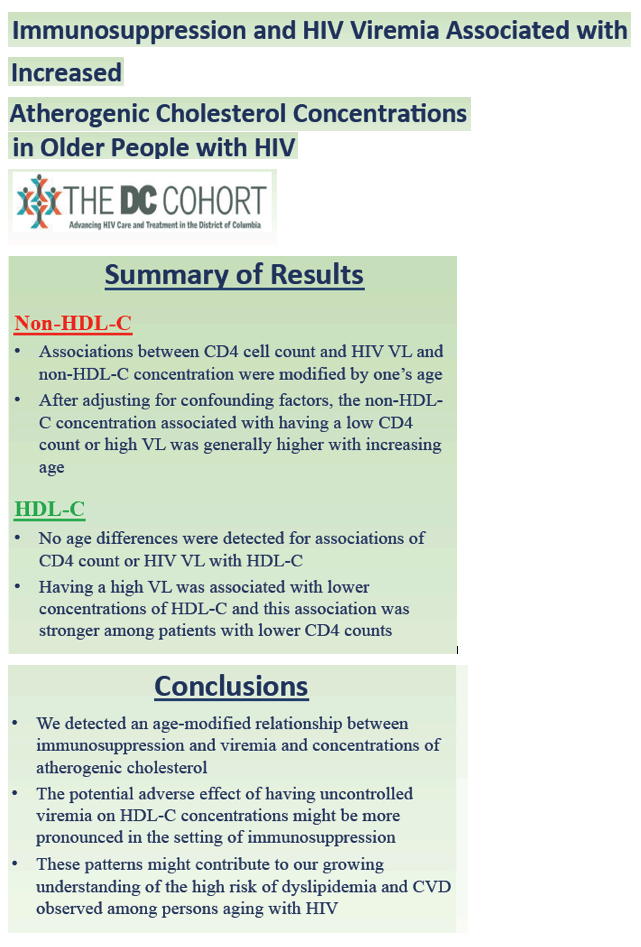
Immunosuppression and HIV Viremia Associated with Increased Atherogenic Cholesterol Concentraions in Older People with HIV
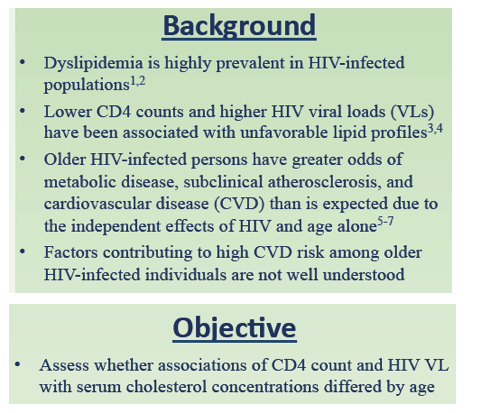
MaIhew E. Levy1, Alan E. Greenberg1, Manya Magnus1, Naji Younes1, and Amanda D. Castel1, on behalf of the DC Cohort Execu/ve CommiIee
1 Department of Epidemiology and Biostatistics, The Milken Institute School of Public H ealth at the George Washington University, Washington, District of Columbia (DC), USA
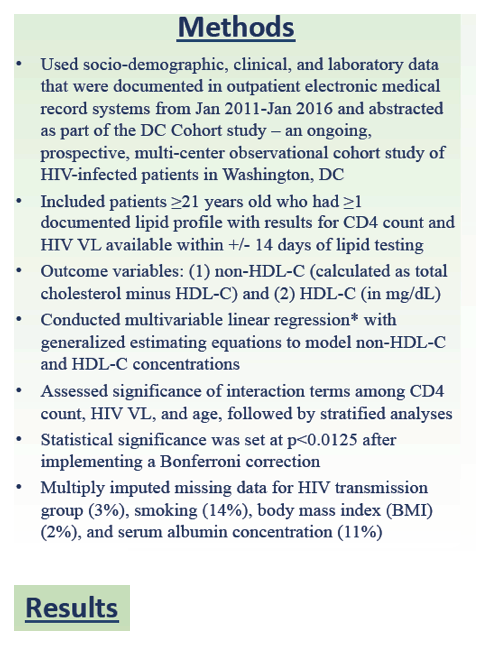
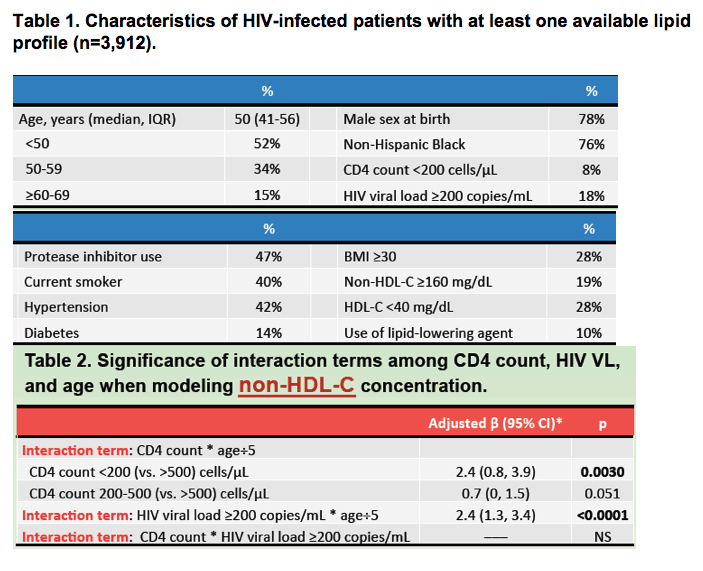
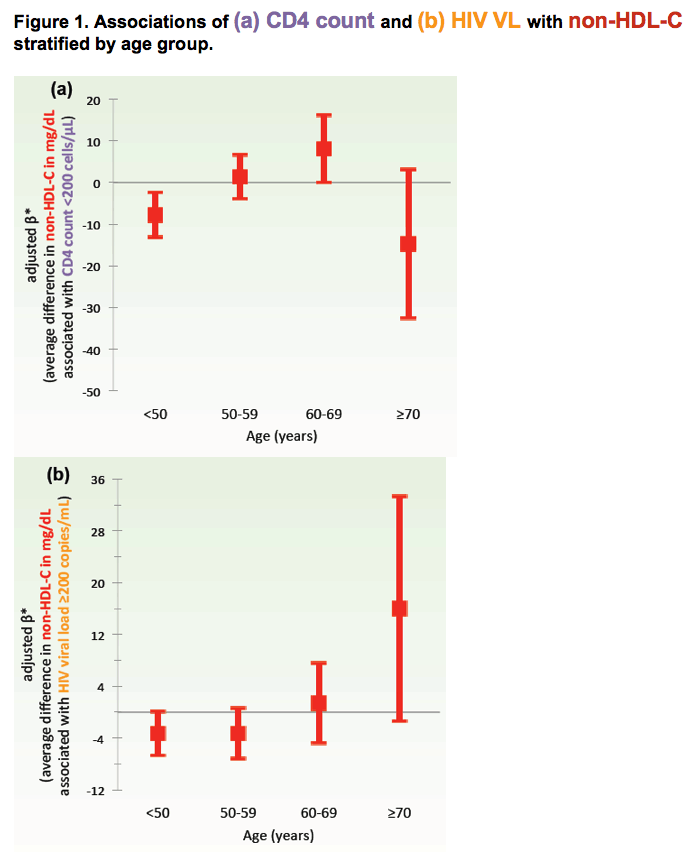
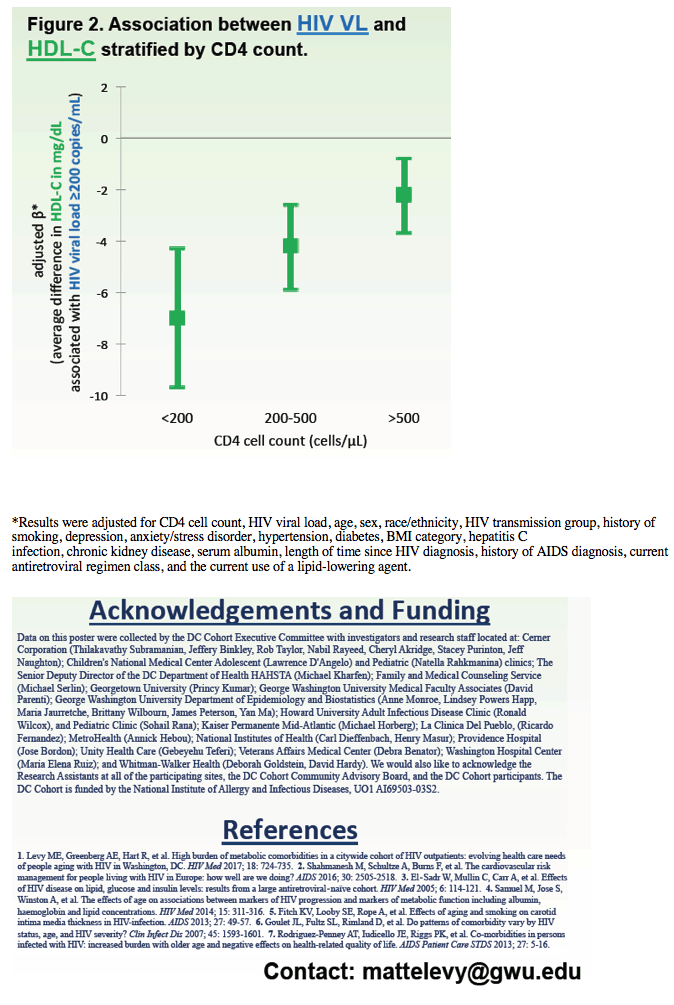
|
| |
|
 |
 |
|
|